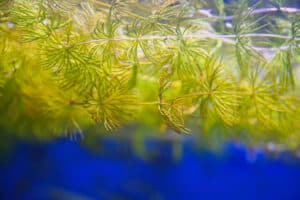Creeping jenny is a beautiful plant that can be found growing expansively in a variety of settings, from natural areas to gardens to inside the home. This plant has also become popular in aquariums, but can creeping jenny grow underwater?
Creeping jenny can be grown in an aquarium or underwater; it grows a little bit differently depending on its environment. So long as you meet the plant’s needs when growing it, it makes a lovely addition to an aquarium.
Below we will explore how to plant creeping jenny in underwater settings and how to make it a beautiful addition to your aquarium.
Can Creeping Jenny Grow Underwater?
Creeping jenny is quite a versatile plant and can grow underwater. This makes it a top choice for those wishing to add some greenery to their aquarium or water fixture outdoors.
In a natural setting, creeping jenny thrives in various water-filled areas, such as ponds, lakes, streams, and bogs. It helps keep the water clean of any toxic elements such as algae and helps to keep the water looking clear.
Growing Creeping Jenny In An Aquarium
There are particular conditions you’ll want to meet in your aquarium to make sure your plants can flourish. The ideal temperature is colder water, between 15 and 25 degrees Celsius.
In terms of acidity, creeping jenny prefers levels between 6 and 8 pH. They also prefer a lot of consistently bright light.
Before placing any creeping jenny inside an aquarium, you want to wash it thoroughly.
Given that it’s often cultivated with insecticide to protect it from pests and damage, any traces of this must be removed from the plant before hitting the water. These insecticides can be very harmful to your fish.
In order to properly clean your creeping jenny, you should submerge the plant into some water with baking soda. This will help disintegrate any remaining chemicals on the plant.
How To Plant Creeping Jenny In Your Aquarium?
In order to anchor the creeping jenny in place, you want to carefully plant it within some substrate and use aquarium gravel or stones to keep it anchored to the ground.
Aquarium soil for your creeping jenny would also be of benefit to keep it healthy without causing any damage to your fish.
The type of creeping jenny that can be used in an aquarium setting won’t grow to cascade or “creep” all over the floor of the aquarium. Instead, it tends to grow straight up.
Lighting For Creeping Jenny
Adequate lighting is absolutely necessary for your aquarium’s creeping jenny. If you have a bright light above your aquarium set up, that should be adequate.
If the lighting is poor, you can ensure that your plant gets enough light by letting it float towards the surface of the water.
The type of lighting recommended is one that can reach a depth of at least 45 par. This should ensure the light reaches the plant appropriately, regardless of where you’ve placed it.
Moreover, if you have a very large aquarium, it’s worth investing in more than one light.
Read: How Long Should You Keep The Light On In A Fish Tank?
Avoiding Overgrowth In The Aquarium
If left to its own devices, these plants can grow quite large and spread dramatically. If you find your plant is overgrowing in your aquarium, you can just snip the top and replant it somewhere else.
That said, they do grow slow before they are able to spread out.
Keeping your creeping jenny properly anchored in the aquarium and providing it with the right light is the best way to encourage growth.
Of course, you still want to monitor and maintain the plant so that it doesn’t overflow the aquarium or start growing around the aquarium if there are openings at the top.
You should also be aware that if you want to have other live plants in your aquarium, your creeping jenny could end up growing towards them and eventually suffocate the other plants.
This is part of why some countries believe that these plants are invasive.
Thus, it’s better to keep creeping jenny as your only live aquatic plant within an aquarium.
Maintaining Creeping Jenny Underwater
Creeping jenny also enjoys having nutrients occasionally added to the water to help it grow.
Maintaining the plant with grooming and pruning every now and then will ensure growth doesn’t get uncontrollable.
If left unmaintained, the creeping jenny could take over the entire aquarium, leaving little room for fish to swim around.
Liquid fertilizer is also recommended to make sure your plants get enough oxygen and continue to flourish.
That being said, creeping jenny is a lot easier to maintain within water than some other types of aquarium plants. You should add a small amount to the water every week or so.
You should be on the lookout for any leaves that appear to be melting, especially if your plant has grown tall or is starting to float. This melting happens due to the plant being too close to the warm lights. You can easily cut these parts off to avoid killing the entire plant.
The Benefits Of Creeping Jenny In An Aquarium
Creeping Jenny doesn’t just add a green element to your aquarium. It can actually be a great benefit to the environment that keeps the water safe and clean for your fish.
Your fish will also appreciate having creeping jenny in their aquarium.
These soft plants offer sanctuary for fish when they want to get away from other fish. It can also be a nice place for them to hide and get some rest.
Having a place to be away from the rest of the fish in the aquarium can help your fish when they’re feeling stressed.
When fish are stressed out, they are more likely to attack each other.
Creeping jenny can also help keep the nitrates within the water under control. Monitoring the amount of nitrates in your aquarium is crucial to your fish’s health.
They can cause your fish to become very sick and stressed out.
Nitrates are not bad for your creeping jenny; in fact, these plants essentially soak up the nitrates to help remove a surplus of these harmful compounds.
Types Of Fish Suitable To Live With Creeping Jenny
Most types of fish that are suitable for aquarium life will enjoy having some creeping jenny in their space.
As mentioned, it offers some safety and solitude for fish that are looking to be alone to relax.
The plant also happens to absorb light well, so if you have fish that aren’t a fan of super bright lights, the creeping jenny can help with that.
Fish don’t tend to want to eat these plants, and even if they take an occasional nibble, it won’t be harmful for your fish.
There are some fish that will destroy the plant, leaving a mess for you to clean up. Fish that enjoy shredding up plants, such as Oscars, will just rip them apart, leaving all your hard work wasted.
Final Thoughts
Creeping jenny are versatile plants that can grow in many conditions, including underwater. This is one of many reasons why so many fish parents enjoy having creeping jenny in their aquariums. While they do require some maintenance, they are overall very easy aquatic plants to cultivate and blossom underwater with a few simple tips.
You May Also Like To Read:
Hi! I’m Praveen Ghoshal, the founder of eFishkeeping.com. Inspired by my Dad, I got interested in fishkeeping when I was a kid. Since then, I have been involved with this hobby. Currently, I have 3 fish tanks at our home, and I enjoy this hobby with my full family. Read more about me here.




![Why Are Anubias So Expensive? [Reasons + Cheap Alternatives] why-are-anubias-so-expensive](https://efishkeeping.com/wp-content/uploads/2022/12/anubias-in-a-planted-aquarium-300x200.jpg)



